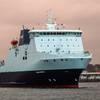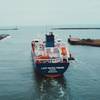Dynamic positioning system failures on offshore supply vessels engage in oil and gas operations in the U.S. Outer Continental Shelf
The U.S. Bureau of Safety and Environmental Enforcement (BSEE) has issued a Joint Safety Alert addressing a dynamic positioning (DP) incident involving an offshore supply vessel (OSV) which resulted in a loss of position while conducting a critical Outer Continental Shelf (OCS) activity.
The OSV was attached to a wellhead, lost position and severed the wellhead tree causing a lubricant release on the platform deck and to the environment. Immediately prior to the position loss, the OSV had multiple DP system alarms and failures, including loss of bow thruster and engine control. No attempt was made to identify or correct the causes of these failures and the operations continued.
At the time of the position loss, the OSV was being utilized to support pump and electric line equipment which was connected to the well at the time of the incident. Specifically, when the vessel lost position, the vessel operator was in the process of removing a downhole DX plug from the well via wireline. High pressure pump lines were also connected to the well, although actual pumping operations were not in progress. When the vessel lost position, the Christmas tree was sheared from the well because of the force exerted on it by virtue of the connected high pressure lines. Severe consequences were averted because a subsurface safety valve was activated and there was an absence of hydrocarbon flow from the well.
The OCS activity performed was critical due to the short time to terminate and the potential uncontrollable release of hydrocarbons from a well with known sustained casing pressure. The Coast Guard and the BSEE are issuing this joint Safety Alert because we share jurisdiction on the OCS and wish to highlight the importance of an OSV’s Safety Management System (SMS) and a leaseholder’s Safety and Environmental Management System (see Reference 1).
BSEE said this incident highlights the following critical issues:
Alarms: The Coast Guard and BSEE stress the importance of properly acknowledging and investigating all alarms, and taking immediate and positive corrective action prior to initiating or proceeding with any critical OCS activity.
SMS: The OSV was not required to and did not have an International Safety Management (ISM) Code certificate. The Coast Guard reminds OSV owners and operators that an effective SMS is essential to safe operations, particularly when those operations are critical OCS activities. Had the OSV implemented an effective SMS, as described in the ISM code, it likely would have:
- Had adequate emergency disconnect capability and procedures for loss of position events and personnel trained in those procedures. In this case the OSV did not have adequate emergency disconnect capability, procedures or training records;
- Ceased the critical OCS activity after experiencing multiple DP system failures - including engine and thruster loss - and not have resumed the activity until after correcting the causes of the DP system failures (see Reference 2).
Dynamic Positioning: The Coast Guard strongly recommends owners and operators of OSVs using DP to follow DP guidance provided in reference 3 (Marine Technology Society (MTS) DP operations guidance) when conducting critical activities on the U.S. OCS. See the applicable notice on this topic published in the Federal Register (77 FR 62247, October 12, 2012) for more details. Had this OSV followed the MTS DP operations guidance it likely would have:
- Had a DP system that met a minimum of DP Equipment Class 2 (DP-2). The involved OSV’s DP system was DP Equipment Class 1 (DP-1), which means that a loss of position may occur in the event of a single failure. (see Reference 3, paragraph 4.1);
- Had an Activity Specific Operating Guideline (ASOG) that prescribed emergency disconnect procedures and capability to prevent equipment damage and pollution. The involved OSV did not have an ASOG defined. The sample ASOG in MTS DP guidance recommend the operator should “halt operations and initiate contingency procedures” for thruster and generator failures, which this OSV experienced prior to the loss of position incident. (see Reference 3, Appendix C);
- Had a Critical Activity Mode of Operation (CAMO) defined. The involved OSV did not have a CAMO defined. The sample CAMO in MTS DP guidance recommend the operator change operating condition from “normal operations” to “informative/consultative status (risk assess)” when any change occurs to the normal operations of the DP system, which this OSV experienced prior to the loss of position incident. (see Reference 3, Appendix C);
- Ensured a structured competence assurance program was applied to all key DP personnel. At a minimum DP personnel should be required to demonstrate proficiency in understanding the redundancy concept and emergency procedures to respond in the event of a DP system failure. (see Reference 3, paragraph 4.14).
Leaseholder/operator SEMS: BSEE strongly recommends leaseholders/operators consider Coast Guard recommendations for DP vessels when evaluating potential hazards and establishing/implementing contractor safe work practices in their SEMS program (see 30 CFR §§ 250.1911 and 250.1914). BSEE reminds leaseholders/operators of their critical role in ensuring safety and environmental hazards associated with contracted vessels on their lease are properly managed. For example, leaseholders/operators should ensure hazards associated with a loss of position by contracted DP vessels are analyzed and managed with appropriate contractor safe work practices.
Reference 1: BSEE/USCG Memorandum of Agreement OCS-07 “Safety and Environmental Management Systems (SEMS) and Safety Management Systems (SMS)” (April 30, 2013).
Reference 2: ISM Code Regulations 7 and 10 (2014 ed.).
Reference 3: DP Operations Guidance, Part 2 Appendix 2: DP Project /Construction Vessels (Dynamic Positioning Committee of the Marine Technology Society to aid in the safe and effective management of DP Operations (July 31, 2012).
Reference 4: Marine Technology Society Technical and Operations Guidance (TECHOP) “Defining Critical Activities Requiring Selection of Critical Activity Mode”, TECHOP_ODP_12_(O) (January 2014).













